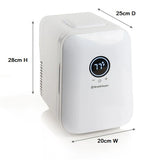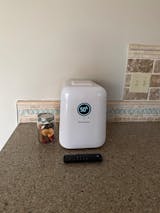Sourdough Home
Sourdough Home
Specifications
- Temperature Range: 41-122F / 5-50C
- Outside Dimensions: 11in H x 8 W x 10 D (28 x 23 x 25cm)
- Inside Dimensions: 7½in H x 5⅛ W x 5 ½ D (19 x 13 x 14 cm)
- Weight: 4.1 lbs, 1.86 kg
- Voltage: 100-240V
- Efficiency: To maintain a stable temperature, the Sourdough Home constantly adjusts the heating or cooling power. Temperature settings close to the ambient room temperature will require a very small amount of power, while temperature settings significantly above or below room temperature will require more power.
- Maximum Power Usage: Maximum power in cooling mode: 38W – maximum power in heating mode: 20W.
- Sourdough Starter Jar: Sold Separately
FAQ
Why should I keep my starter in the Sourdough Home?
The Sourdough Home maintains your starter at a consistent temperature so you can reduce feedings, minimize discard, and bake on your own schedule. It eliminates temperature fluctuations, simplifies maintenance, and gives you flexibility with feeding frequency.
Do I still need to feed my starter every day?
Nope! That’s one of the best things about the Sourdough Home. By lowering the temperature, you can slow fermentation and feed your starter every 2, 3, or even 5 days. No need to stick to a rigid schedule or waste flour. It’s sourdough—on your terms.
Will this reduce discard?
Yes. Because you’re feeding less often, you’ll naturally create less discard. Many bakers find this to be one of the most satisfying benefits of using the Sourdough Home.
Can I still bake every day with the Sourdough Home?
Absolutely. Just set the Sourdough Home to a warmer temperature (around 76–78°F / 24–26°C) to keep your starter active and ready to use daily.
Can’t I just store my starter in the fridge?
You can—but fridge temperatures are usually too cold (around 38°F / 3°C). That often weakens your starter and requires extra feedings to revive it. The Sourdough Home keeps your starter cool but still active, so it’s healthier and ready to bake with when you are.
How is the Sourdough Home different from the Folding Proofer?
The Sourdough Home heats and cools, while the Folding Proofer only heats. That means the Sourdough Home can hold your starter below room temperature to slow fermentation. It’s also more compact and designed specifically for starter jars up to 1 liter (1 quart). The Folding Proofer is larger and better suited for proofing dough or bulk fermentation.
What size jars fit inside?
The Sourdough Home fits jars up to 1 liter (1 quart). It works with most standard glass jars, including Weck and Ball. Want the perfect fit? Check out our Sourdough Starter Jar
Does it work with gluten-free or rye starters?
Yes! The Sourdough Home works with all types of starters—gluten-free, rye, whole wheat, and more. Temperature is key, no matter what flour you use.
Do I need to monitor or adjust it regularly?
Not at all. Just set your desired temperature and let it run. The Sourdough Home maintains a stable environment with no babysitting required.
How long will it take for my starter to reach the set temperature?
The time to reach the set temperature depends on the amount of starter and its initial temperature. To speed things up, feed your starter with water close to your set temperature (warm or cool, depending on the target). The Sourdough Home is a low-power unit, so plan for slower transitions, especially for big temperature changes.
Why doesn’t the temperature of my starter exactly match the display?
The Sourdough Home is designed to keep your starter within an optimal range—within 1–3°F of the set point. That slight variance is normal and doesn’t affect performance. What matters more than the exact number is how your starter behaves: is it rising well? Bubbling? Smelling pleasantly sour? If yes, then your starter is thriving—even if the thermometer shows a small difference.
How do I check my starter’s actual temperature?
Use a digital probe thermometer inserted directly into the starter after it’s been in the unit for a few hours. Measuring the air inside won’t give you an accurate reading.
Where should I keep my Sourdough Home?
Anywhere with stable room temperature works—like a kitchen counter. Avoid placing it next to ovens or in direct sunlight, and allow a few inches behind the unit for airflow.




























